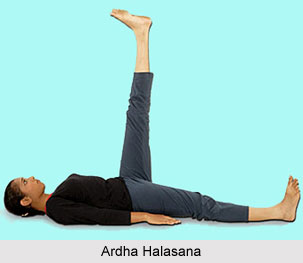 One of the major health problems faced by women is the menstrual disorders. An irregular menstrual cycle may result from some abnormalities, physical disorders, emotional and hormonal disturbances. Improper development of reproductive organs, imbalance of hormones of endocrine glands, weak muscles of reproductive organs, weak constitution, pathological development and psychological disturbances like depression, fear, stress and mental tension are also the causes for menstrual disorders. Yogic treatments can be beneficial in treating such health problems.
One of the major health problems faced by women is the menstrual disorders. An irregular menstrual cycle may result from some abnormalities, physical disorders, emotional and hormonal disturbances. Improper development of reproductive organs, imbalance of hormones of endocrine glands, weak muscles of reproductive organs, weak constitution, pathological development and psychological disturbances like depression, fear, stress and mental tension are also the causes for menstrual disorders. Yogic treatments can be beneficial in treating such health problems.
Some of the common menstrual disorders are as follows:
1. Amenorrhea
This refers to the absence of menstruation. It may be caused by a hormonal imbalance, obesity or extreme weight loss, emotional disorders and others.
2. Menorrhagia
There is an excessive bleeding during menstrual cycles, in terms of more days as well as the amount of blood. Disturbances in pituitary, thyroid and ovary functions, hypertension, and diabetes mellitus are the main causes.
3. Metrorrhagia
There is excessive flow of blood occurring between two menstrual periods. The main causes are poor functioning of ovaries, pituitary and thyroid glands, poor blood clotting function, some psychological factors, and lesions of the cervix.
4. Dysmenorrhea
Pain and discomfort is felt prior to the onset of or at the time of menstruation. The pain primarily occurs in the lower abdomen. There is also pain in the thighs and a general feeling of pressure. Causes of Dysmenorrhea are anatomical malformation like undeveloped womb, hormonal disturbances and mental factors. Sometimes, when the pain is severe, other complaints such as nausea, vomiting or headache interfere with the normal activities.
5. Pre-Menstrual Tension
Many women suffer from this complaint for a week or 10 days before the onset of menstruation. The symptoms are headache, tremors, irritability, heaviness in breasts and pelvic region.
The condition of Amenorrhea may not be having any particular symptom except obesity resulting from hormonal disorder. Women suffering from Menorrhagia and Metrorrhagia complain of pain and weakness and may be unable to carry routine work in case the bleeding is severe. Dysmenorrhea is associated with presence of pain in the lower back and hypogastrium.
Regular and proper practice of yoga asanas and Pranayama is beneficial for women who suffer from the menstrual disorders. However, it should be noted that, during menstruation yoga practices are not advisable for 3-5 days. Proper rest, medicines and relaxation are also necessary. Yoga helps by correcting and balancing the functioning of the endocrine system, toning up of the nervous system and it also relaxes the body and mind, thus, reducing the psychological problems.
 Yoga asanas, such as, Tadasana, Vrikshasana, Chakrasana (sideward bending), Trikonasana, Bhujangasana, Ardha-salabhasana, Ardha-halasana with one and two legs, Viparitakarani, Sarvangasana followed by Matsyasana, Dronasana, Pavana muktasana, Setubandhasana, Vajrasana, Padmasana, Parvatasana, Vakrasana, Gomukhasana, Savasana, Makarasana are recommended for treating these kinds of health related problems in women. Pranayamas like Anuloma-Viloma, Shitali, Bhramari; meditation and the recitation of Om mantra also prove to be helpful.
Yoga asanas, such as, Tadasana, Vrikshasana, Chakrasana (sideward bending), Trikonasana, Bhujangasana, Ardha-salabhasana, Ardha-halasana with one and two legs, Viparitakarani, Sarvangasana followed by Matsyasana, Dronasana, Pavana muktasana, Setubandhasana, Vajrasana, Padmasana, Parvatasana, Vakrasana, Gomukhasana, Savasana, Makarasana are recommended for treating these kinds of health related problems in women. Pranayamas like Anuloma-Viloma, Shitali, Bhramari; meditation and the recitation of Om mantra also prove to be helpful.
Besides practicing yoga a correct approach to life, regular diet, exercise and hygiene are quite essential for the normal development and functioning of the reproductive organs. The yogic postures are helpful to preserve the general health and to reduce the minor complaints regarding menstruation by improving the vigour and strength of the body.
While practising yoga it should be kept in mind that its number and the sequences should be modified according to the capacity and other conditions of the person. One must avoid practicing yoga by only observing T.V. or by reading a book on therapy. The practices should be learnt from a qualified Yoga therapist. Apart from these one can take rest either in Savasana or Makarasana in between two asanas. At the end, Savasana must be practiced at least for 15-20 minutes. Concentrating on stretching and breathing movements during the practice helps to avoid distractions. As far as the diet is concerned it is better stick to a moderate vegetarian diet.
Yoga asanas prescribed above should be strictly performed under the supervision of an experienced Yoga teacher.




















